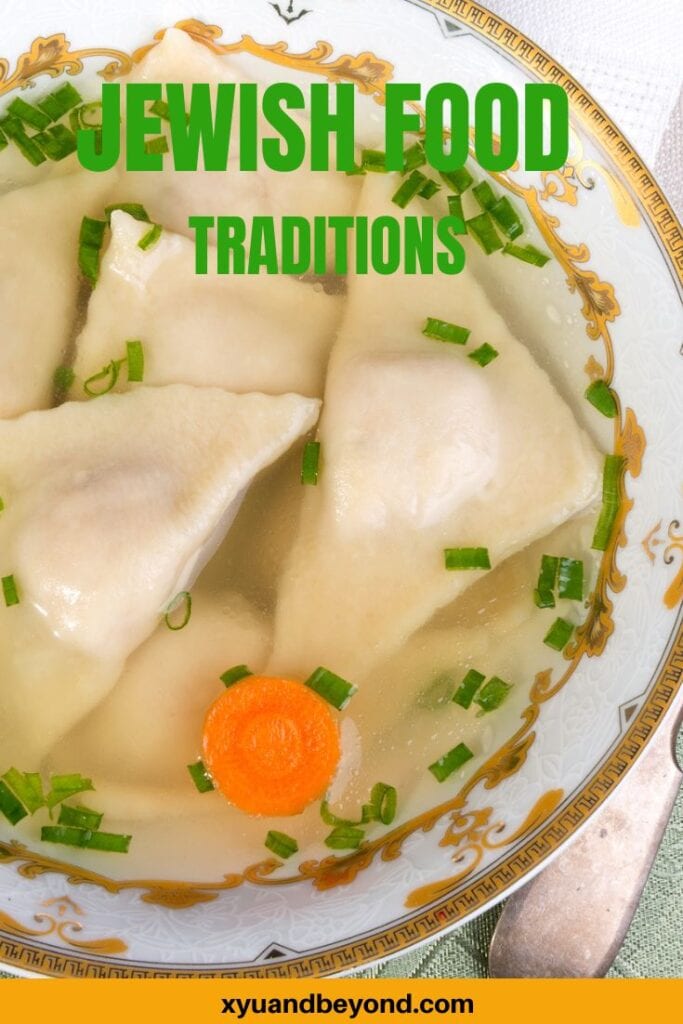Jewish food and Jewish food traditions
When travelling for food we often come across dishes that we know are related to traditional Jewish foods. These dishes have been handed down for centuries and have become enmeshed in the cultures where Jewish people landed.
Jewish food and Jewish cuisine are not easy to put into a box and label as Jewish. The diaspora suffered by Jews over the centuries has meant that many Jewish people have had to incorporate the ingredients at hand and fit them within the laws of Kashrut (the dietary laws also known as Kosher). Other religious requirements for keeping the Sabbath mean there are prohibitions about creating fire on Shabbat and in many ultra-orthodox homes, electricity use is forbidden. These. naturally led to dishes that could be prepared and cooked well ahead of the Sabbath.
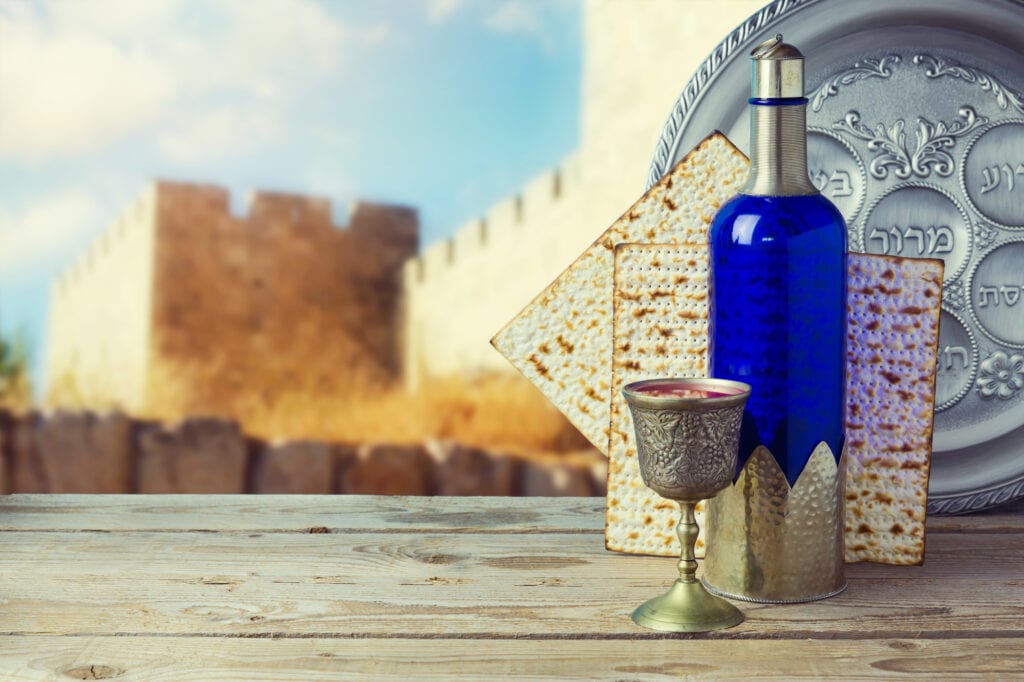
Jewish food also bears the marks of these migratory patterns and a background that includes socio-economic status and access to food goods. Jewish food culture also varies depending on the regions that Jewish people moved to. We found Jewish food favourites in Krakow, London, Canada, Spain, Turkey, Ireland, Italy, Cyprus and France, each of these countries had Jewish populations and their food traditions became incorporated within the local populations over centuries.
Jewish food history
There are 3 main styles of traditional Jewish cuisine and they are Ashkenazi, Sephardi, and Mizrahi. Other cultural influences on Jewish food include Persian, Yemenite, Indian and Latin-American as well as the influences on Jewish dishes from Central Asia to Ethiopia.

Check out these Ethnic restaurants – New York
- Jewish food and Jewish food traditions
- Jewish food history
- Jewish food traditions – keeping Kosher
- Jewish food – Ashkenazi
- Jewish food in America
- 29 Jewish food favourites
- Gefilte Fish
- Babka
- Bagel and a schmear
- Kibbeh
- Borscht with sour cream
- Lokshen
- Shakshuka
- Bazargan
- Latkes
- Fried Artichokes
- Rugelach
- Matzoh Balls
- Kugels
- Kreplach
- Chicken Soup
- Challah bread
- Hamentash
- Knishes
- Pierogis
- Chopped Liver
- Cabbage Rolls or Holishkes
- Carrot tzimmes
- Potato bourekas
- Chamin/Cholent
- Blintzes
- Brisket
- Pastrami
- Montreal Smoked meat
- Sufganiyot
Xyuandbeyond is reader-supported. When you buy through links on our site, we may earn an affiliate commission. You can read my privacy policy here.
What is traditional Jewish food?
Israeli cuisine is recognized worldwide these days thanks to Chefs like Yotam Ottolenghi, Mike Solomonov and Eyal Shani who brought us Israeli foods and introduced us to Middle Eastern dishes and spices like sumac and za’atar. Israel has a strong foodie base and a growing reputation for some amazing culinary creations. Street Food in Jerusalem is a star in the shuk (also known as the souk) which is a Jewish market in the centre of Jerusalem and I can’t wait to learn more about this growing cuisine.
Within Judaism, the dietary laws are found in the Torah and laid out in far more detail in the Talmud. These dietary laws governed what and how to eat in ancient times and laid out the types of food-related laws that will apply to those related to particular celebrations, festivals and certain occasions. Traditional Jewish food reflects the food culture of this diaspora and shows up all across the world from the Levant to New York.
Jewish food traditions – keeping Kosher
Keeping kashrut or kosher is the backbone of Jewish food by prescribing and proscribing the allowed foods and how they must be prepared before cooking and then produced and processed. The word kashrut translates to “pure” or “proper”.

There are three main kosher food categories
Meat (fleishig)
This can be the flesh of any mammal except for pigs, rabbits, squirrels, camels, kangaroos, or horses. With regard to poultry or fowl, it is not allowed to eat or cook predator or scavenger birds, such as eagles, owls, gulls, and hawks. When it comes to beef or other meats you are not allowed to use beef that comes from the hindquarters, such as flank, short loin, sirloin, round, and shank cuts.
After eating meat you must wait up to 6 hours depending on the various Jewish customs before you can eat any dairy product.

Dairy (milchig)
You are allowed milk, cheese, butter and yoghurt but they must come from a kosher animal. Dairy products must never be mixed with any meat-based derivatives, such as gelatin or rennet which is used to make a lot of hard cheeses.
They must also be prepared using kosher utensils and equipment that has not previously been used to produce or cook any meat products.
Pareve
Any food that is not meat or dairy, Pareve is considered a neutral category and they do have their own rules but they don’t contain milk or meat and as such can be cooked and eaten along with meat and dairy ingredients.
Jewish food the Rules of Kosher
- Fish is allowed but it is only deemed kosher if it has scales and fins so this means you can eat tuna, salmon, halibut, or mackerel.
- Seafood such as shrimp, crab, oysters, and shellfish of any kind and lobsters don’t have scales and fins and so cannot be eaten.
- If your hens or fish are kosher you can use eggs from them (think caviar or fish roe) as long as there is no trace of blood in the eggs. These can also be eaten with dairy or meat.
- To be considered Kosher meat must have been slaughtered by a shochet (ritual slaughterer) in accordance with Jewish law and is entirely drained of blood. Before it is cooked, it is soaked in water for half an hour and sprinkled with coarse salt (which draws out the blood) and left to sit for one hour.
- Once the salt is washed off the meat it can be sold as kosher. These days any meats labelled kosher must have been produced following these rituals.
- Because the kosher dietary laws state no butter, milk or cream can be used in cooking dishes with meat you will see that non-dairy cream substitutes are used in place of them.
- What is schmaltz? This is simply rendered chicken fat.
Jewish food – Ashkenazi
Ashkenaz in Hebrew refers to Germany, and Ashkenazi Jews are those who originated in Eastern Europe. Sephardic Jews, by contrast, are from the areas around the Mediterranean Sea, including Portugal, Spain, the Middle East and Northern Africa.
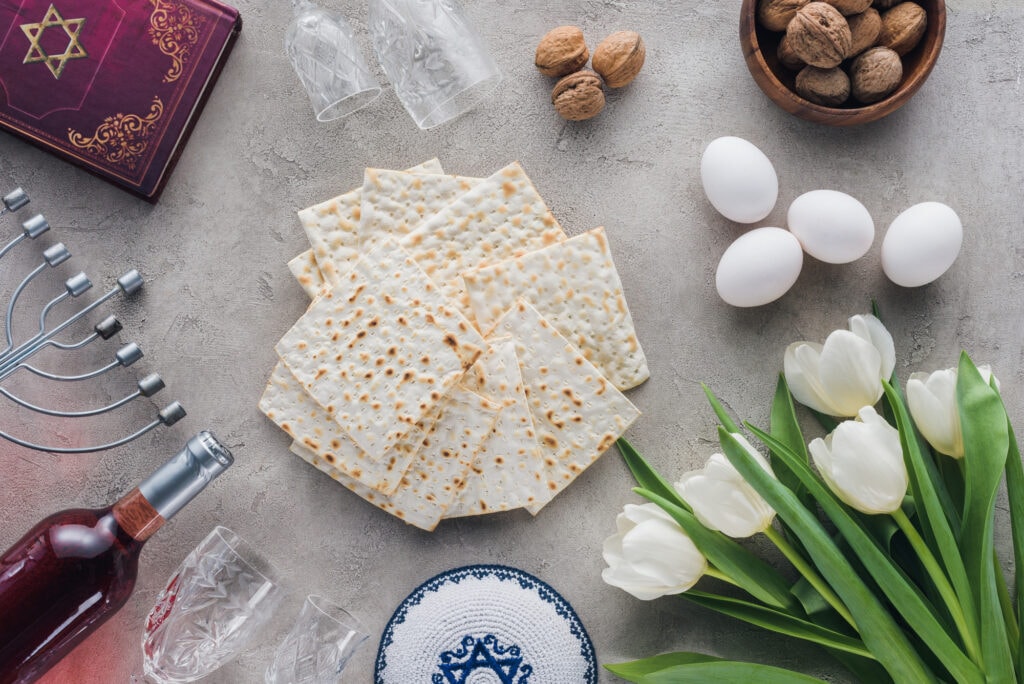
The food of Ashkenazi Jews, soups, stews and warming foods was based on centuries of living in the cold climates of Europe whereas the lighter cuisine, salads, pasta, and vegetable dishes of Sephardic Jews were affected by life in the Mediterranean region.

The Ashkenazi Jews were a distinctly different group and their food reflects the terrible poverty they lived in. The Ashkenazi community spread from Germany eastward into Russia and Poland. What we refer to these days as Jewish food items like bagels, borscht, knishes and latkes arose from the Ashkenazi traditions.
An interesting fact about the history of fish and chips.
Fish and chips the “traditional” British food comes from Sephardic Jewish immigrants who “invented” the dish. they were refugees and immigrants escaping religious persecution in Spain and Portugal.
Jewish Food – Sephardic
Sephardim, or Sephardic Jews, are descendants of the Iberian Jews expelled from Spain and Portugal in the late 15th century. Jewish Sephardic foods originate from the Mediterranean, the Middle East, the Red Sea area, North Africa and even India. In ancient times these lands were part of what was considered the Islamic regions. Jewish people in these areas flourished in the early Middle Ages and the food reflected this economic prosperity.
In 1492 when the Jews were expelled from Spain many of the Sephardic population found their way to North Africa and the Ottoman Empire. Sephardic dishes include stuffed vine leaves, lentils, pine nuts, ground lamb and beef, lemon juice, pomegranates, and chickpeas.
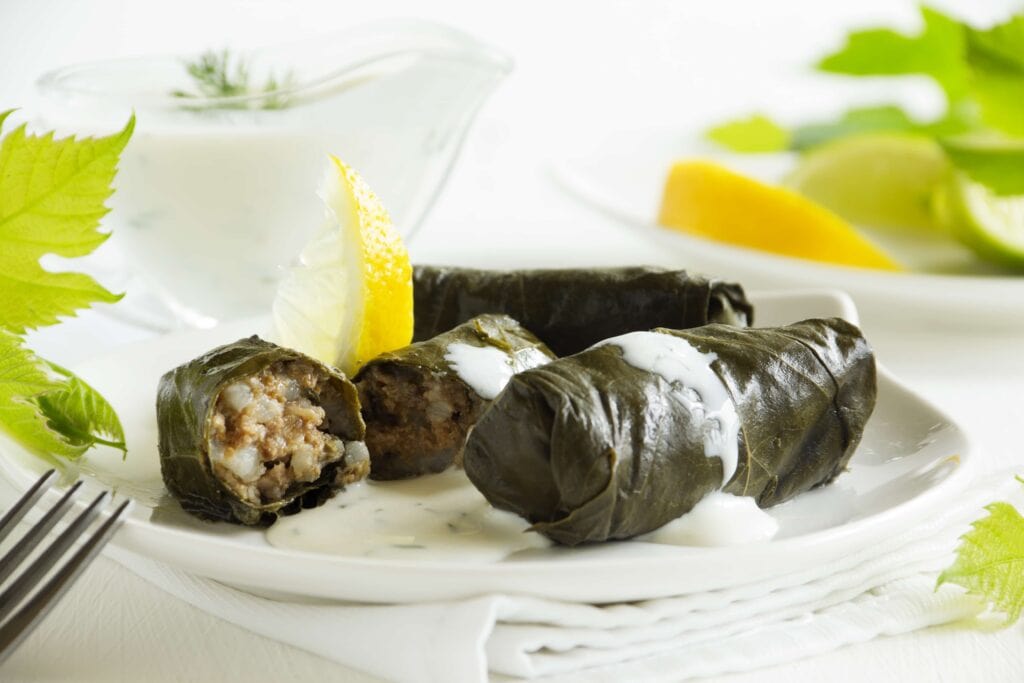
Jewish food -Mizrahi
According to Wikipedia Mizrahi Jewish cuisine is an assortment of cooking traditions that developed among the Jews of the Middle East, North Africa, Asia, and Arab countries. Mizrahi Jews have also been known as Oriental Jews.
A Mizrahi is a descendant of those Jews who historically lived in the Middle East and North Africa before the arrival of Sephardic exiles from Spain and Portugal in the late 1400s. Most present-day Mizrahim live in Israel, Europe, and the United States. Mizrahi cuisine tends to favour lentils, bulghur, flatbreads, and hot sauces such as Skhug and Hilba.

Jewish food in America
Jewish food in America is a somewhat richer version of the Ashkenazi food of Eastern Europe. Jewish American food is deeply influenced by the regions and so you will find things like gefilte fish made with salmon and matzoh ball soup served with hot sauces depending on the area of the US you are in.
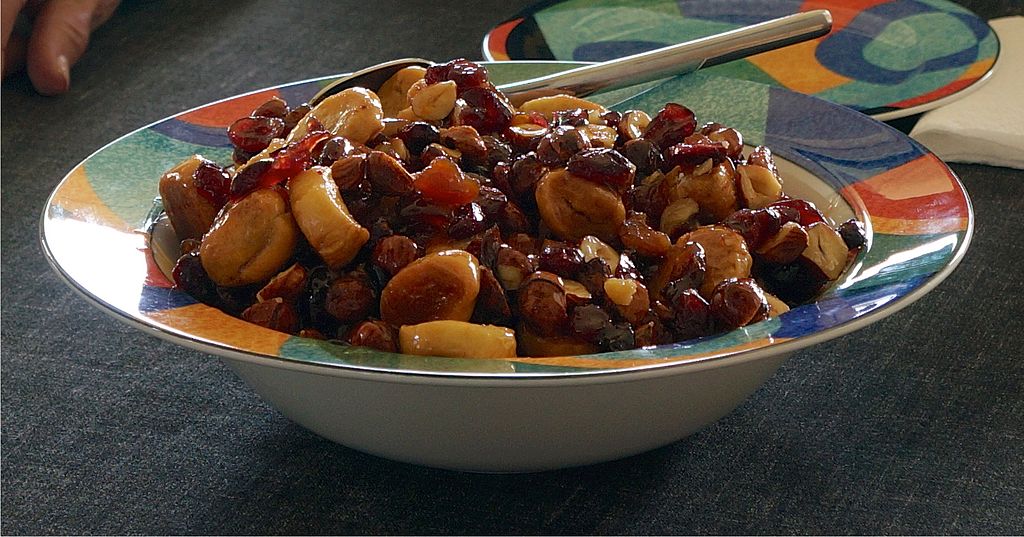
29 Jewish food favourites
Gefilte Fish
One of the classic Jewish foods Gefilte fish is traditionally made by taking deboned and skinned fish that is chopped finely and mixing it with minced and then browned onions. Salt and pepper are used to season the fish and chopped boiled eggs are added to the mixture. This is then fried and served at any time although if following the Orthodox laws it is a perfect dish for the Sabbath as there is a prohibition about separating bones from food while eating.
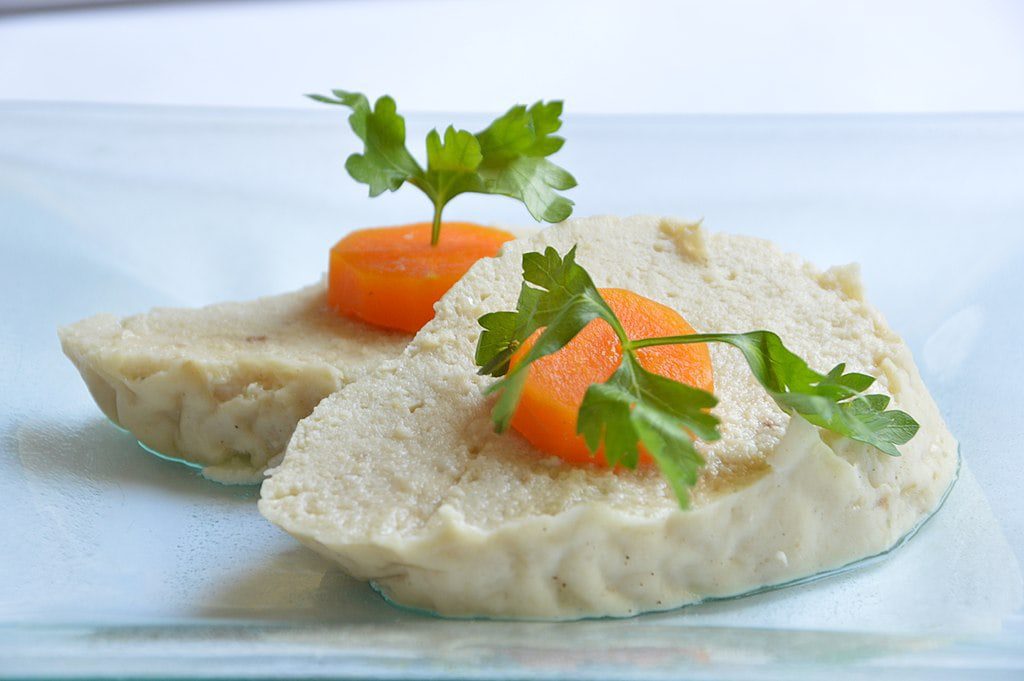
Babka
Babka is a sweet braided bread or cake that uses yeast to raise the dough and when the dough is rolled out it is spread with cinnamon sugar, chocolate, fruit or cheese and then braided before baking.
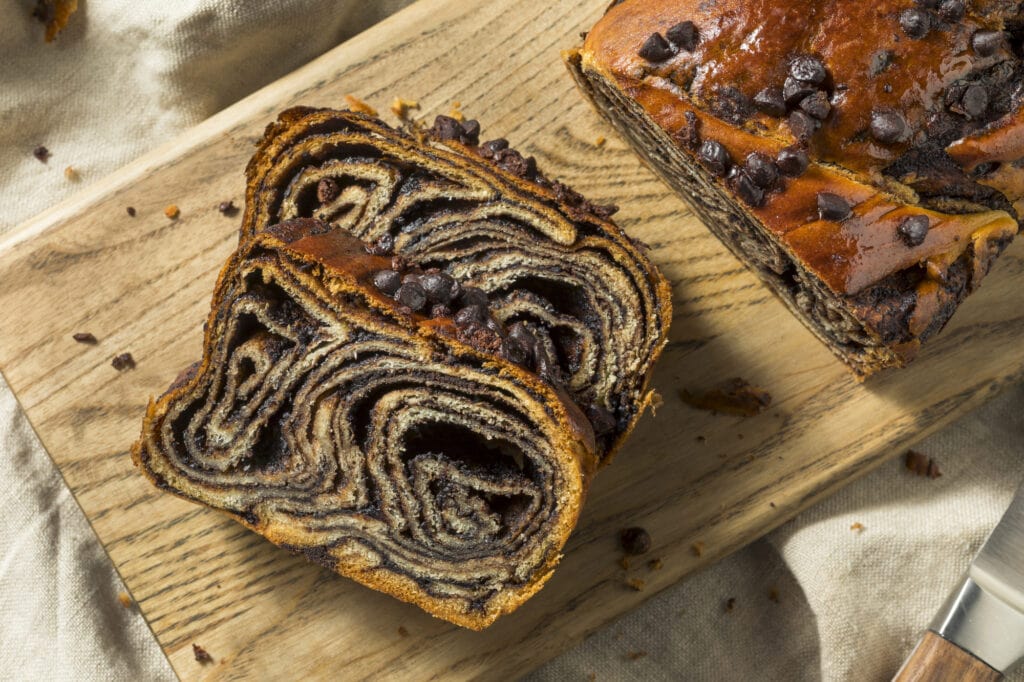
Bagel and a schmear
The combination of smoked salmon or whitefish with bagels and cream cheese is a traditional breakfast or brunch in American Jewish cuisine, made famous at New York City delicatessens.

There is an ongoing argument in N. America as to who has the best bagels, New York or Montreal. There are differences between the two. Authentic Montreal bagels are boiled in water with honey, and as a result, are sweeter than New York bagels. But the bigger difference is that they are cooked in wood-fired ovens, which gives them a crunchier crust and a deeper, richer crust flavour.
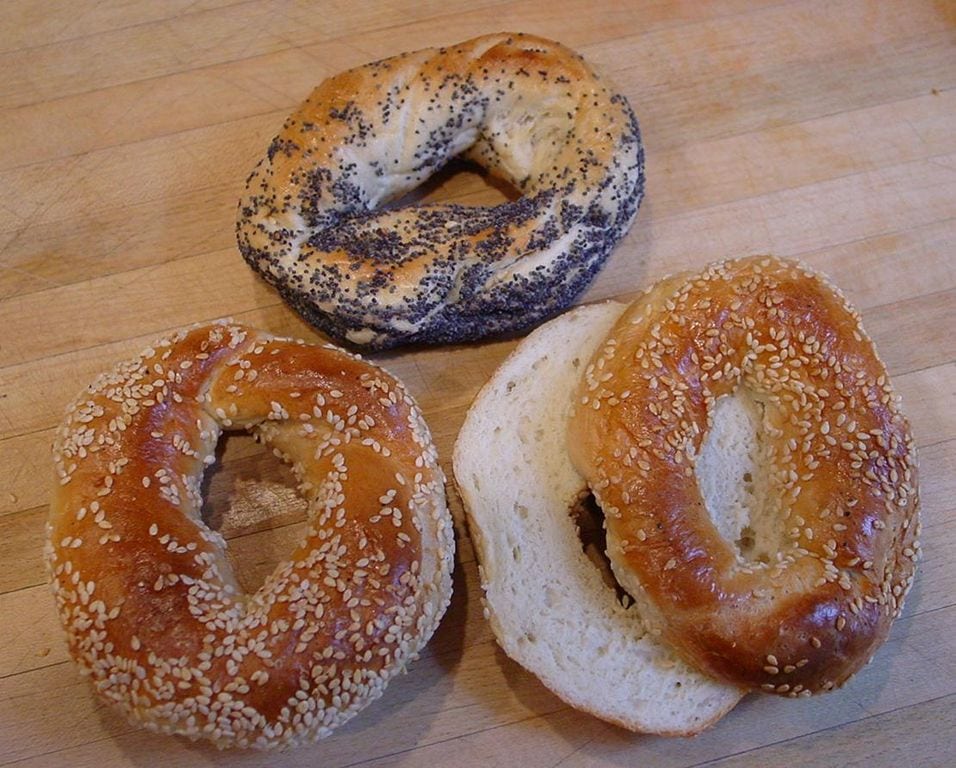
While the Jewish people both came to New York and Montreal from Poland for the most part. The methods of producing and cooking bagels came about as a result of the different areas in Poland in which they lived originally.
Kibbeh
We first ran across kibbeh in Mexico where we were told it was a Lebanese dish that came with the Lebanese immigrants to the country. Kibbeh is bulghur wheat in a football or meatball shape that is stuffed with raw onions in Mexico but can also be stuffed with spinach, pine nuts, and pomegranate seeds.
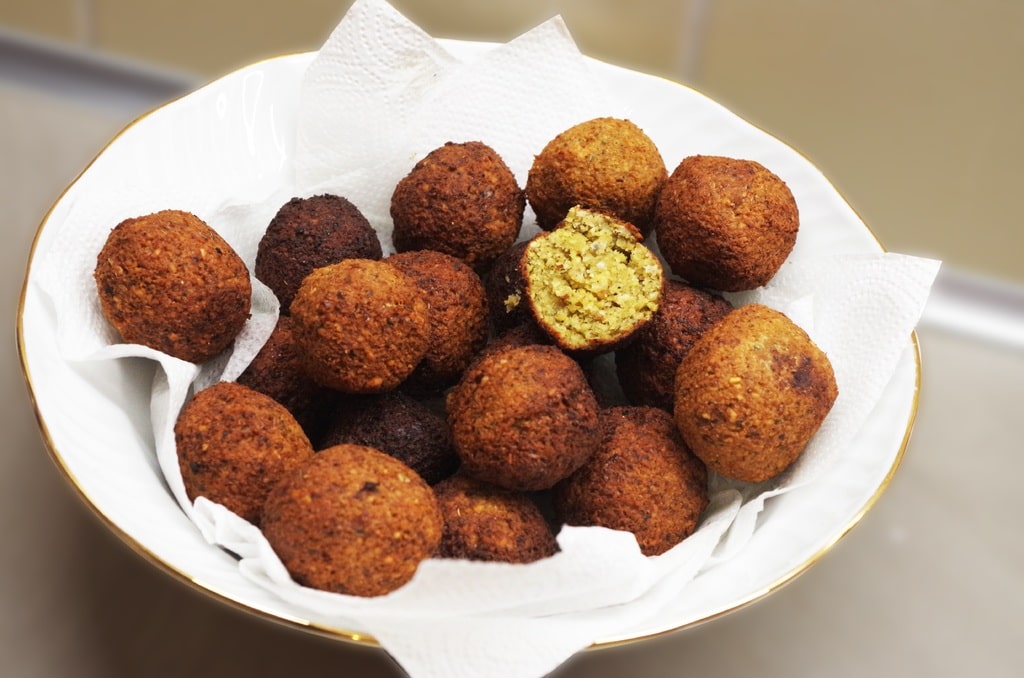
Borscht with sour cream
A number of soups are characteristically Ashkenazi, one of the most common of which is a chicken soup traditionally served on Shabbat, holidays and special occasions. The soup may be served with noodles and is obviously the far superior chicken noodle soup that we all know and love.

Lokshen
These are egg noodles cut into long strips, but they can also be cut into squares and these are called farfel. You can hear some Italian in that. These are usually boiled first and then added to a soup.
Shakshuka
A dish that appears in many middle eastern cuisines Shakshuka was brought to Israel by Tunisian Jews. Shakshuka is essentially eggs poaches in a spicy tomato sauce.
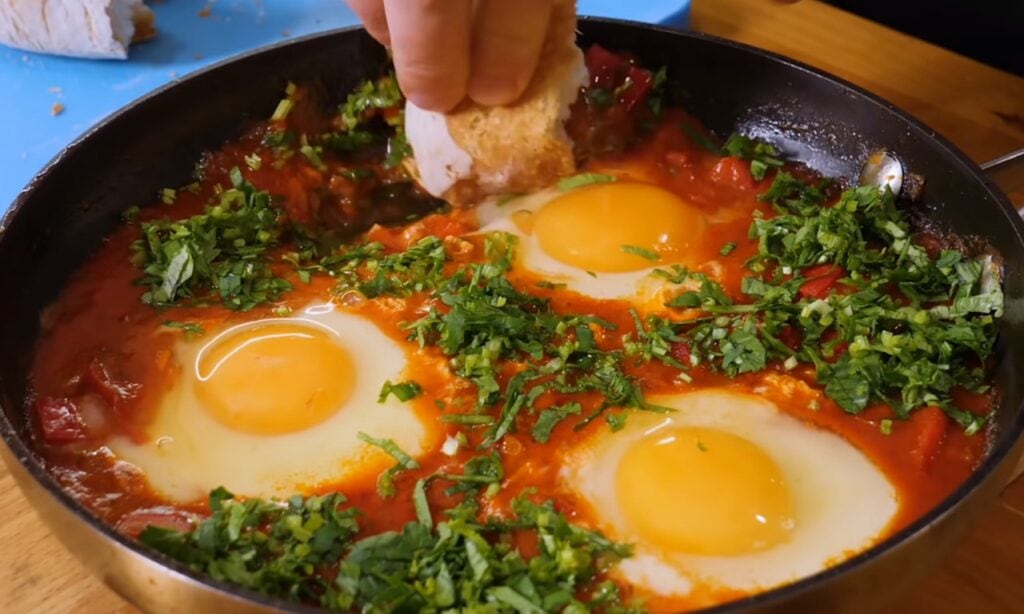
Bazargan
A Syrian Jewish dish this is a vegetarian tabbouleh-like dish. It’s made with cracked wheat, pomegranate molasses, lots of spices and walnuts.
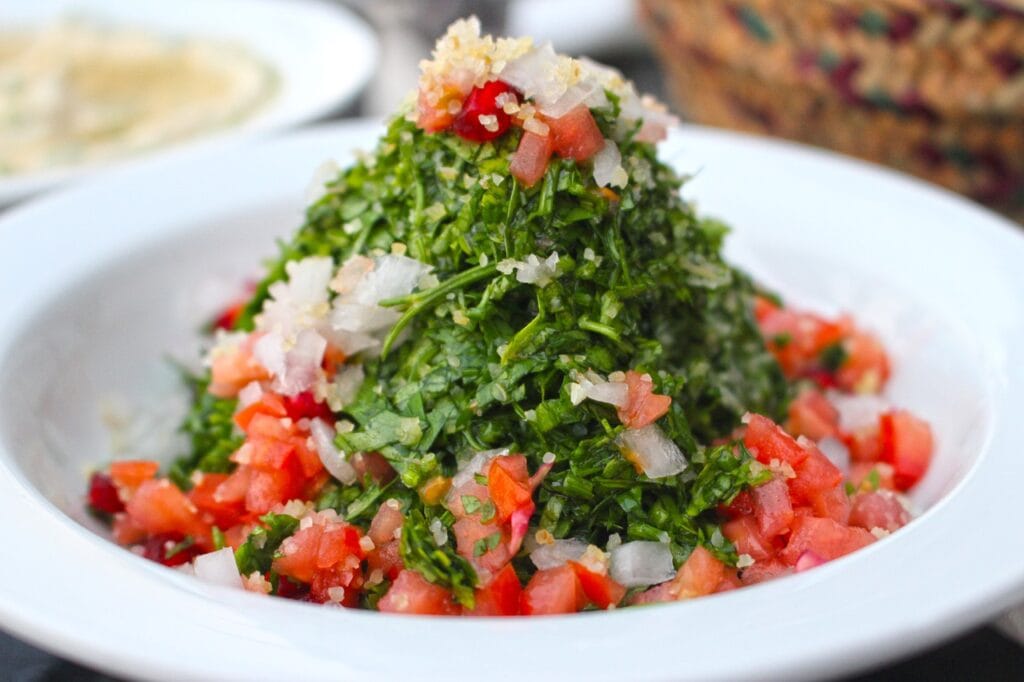
Latkes
Potato pancakes that are fried and served either with sour cream and spring onions or sweet with applesauce. Virtually every country has a potato dish like Latkes. Simply put they are grated or mashed potatoes mixed with flour, eggs, a little milk, flour or matzo meal and baking powder. Potato pancakes turn up in most European cultures, from Polish placki to Irish boxty.

Fried Artichokes
Carciofi alla giudìa, or Jewish-style artichokes, originated in the Jewish-Roman ghetto and are still popular in Jewish-Roman restaurants in the spring when artichokes are in season. It’s basically a deep-fried artichoke with lemon

Rugelach
A sweet cream cheese pastry filled with nuts, poppy seeds, chocolate or jam.

Matzoh Balls
Matzo balls are also known as kneidlach (or floaters and sinkers) are a kind of dumpling. They are made from a mixture of matzah meal, beaten eggs, water, and traditionally schmaltz or chicken fat. These days most are made with oil so they can be vegetarian as well as vegan.
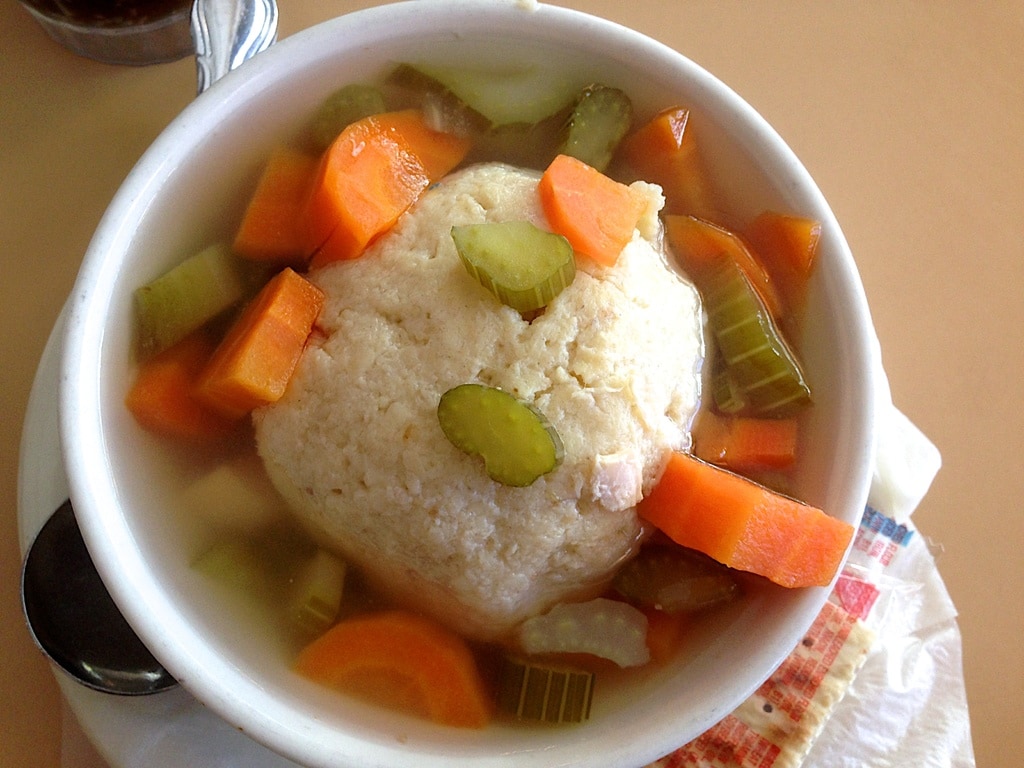
Matzah meal is a type of unleavened cracker-like bread that is traditionally eaten at Passover. It is made with flour and water, and it is the flour-containing product that is deemed to be Kosher for Passover. Matzo meal is made by grinding the crackers into crumbs.
Kugels
Ah, kugels these are a favourite sometimes sweet in a baked noodle (or potato) casserole with spices and raisins, and sometimes savoury with carrots, mixed veggies and potatoes. The name of the dish comes from the Middle High German kugel meaning round or ball. Kugel is an Ashkenazi dish, and at its best, it is a soft-baked noodle or potato dish with various additions.

Kreplach
Kreplach is kind of like ravioli a stuffed dough filled with finely chopped meats or cheese and seasoned with salt and pepper. They are folded into triangles and then dropped into a soup to cook. They can also be fried. They are particularly popular at holiday times like Purim and Hosha’na Rabbah.

Chicken Soup
Or as it is otherwise known Jewish Penicillin. A golden bowl full of pure chicken broth with schmaltz floating on the top. A Jewish mother’s cure for everything, specifically the common cold.

Challah bread
A kosher bread means it is not made with butter, but it does use eggs. This loaf is immensely symbolic in Judaism. It is said to symbolize the two portions of manna that were distributed on Fridays to the Children of Israel during the exodus from Egypt.

Hamentash
Hamentash is those little triangular cookies with the edges folded over and a filling of honey, fruit or poppyseed paste in the centre. It is traditional to eat hamentash on Purim which is a Jewish holiday that celebrates the people being saved from the villain Haman. This comes from the Purim story in the Biblical Book of Esther in the Christian bible and in the Hebrew Bible the Tanakh.

Knishes
Knishes are another favourite of mine. They are handheld pie that contains filings such as meat, potatoes, kasha, sauerkraut, onions, or cheese and these days they are getting gourmet with all kinds of interesting fillings. The Knish is either baked or deep-fried. They first came to New York back in the early 20th century from Poland where they began in the 17th century.
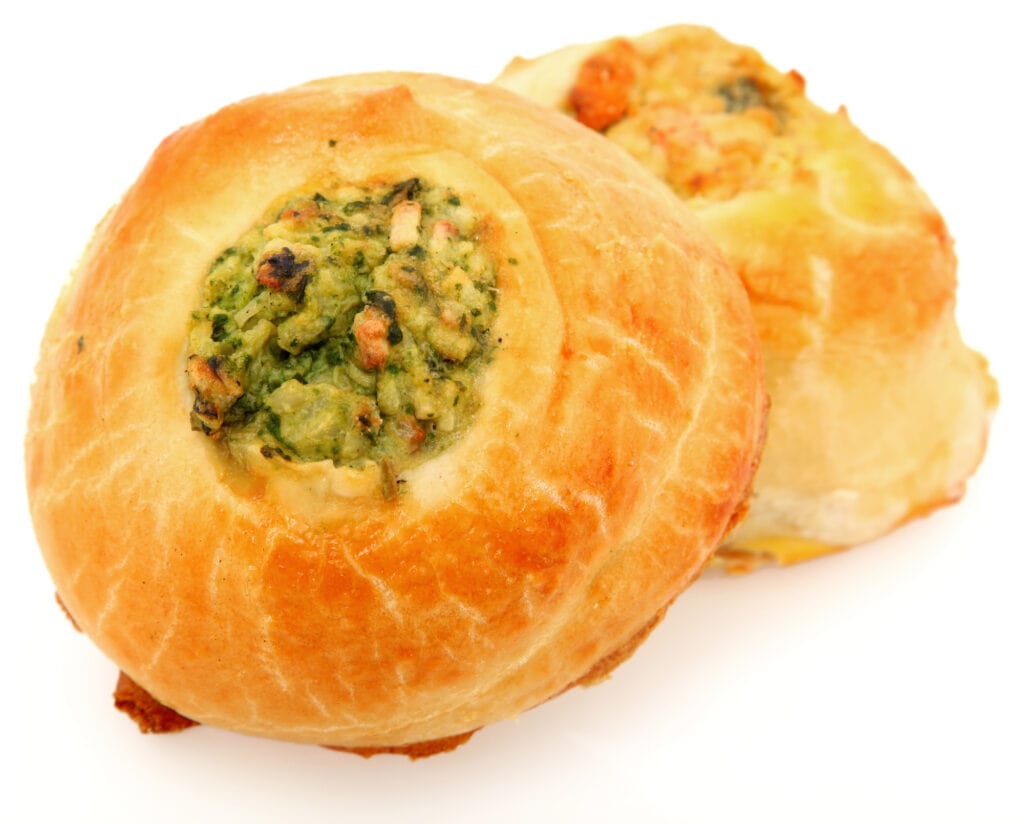
Pierogis
I ate pierogis to my heart’s content when in Krakow Poland these are another dumpling-like dish that is filled with minced beef or combinations of mashed potatoes and cheese, sauerkraut and other fillings are also popular. Served either boiled or fried with a topping of sauteed sweet onions and sour cream it’s a dish that can’t be beaten in my opinion. In the season in Poland, they make sweet pierogis with fresh berries.
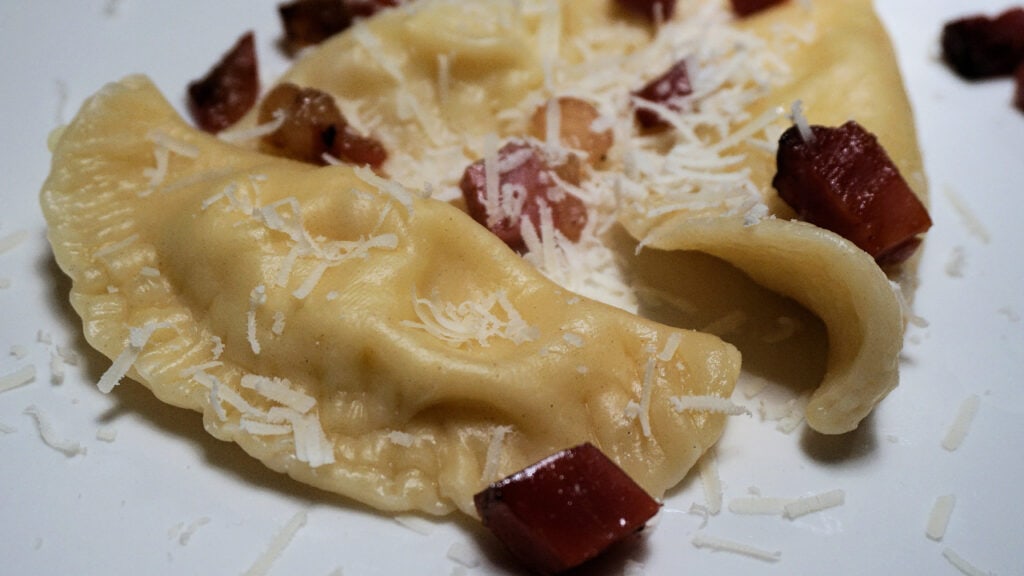
Chopped Liver
A phrase often heard on TV is “what am I chopped liver?” This sort of indicates the fact that chopped liver is an often ignored side dish. However, it’s a pretty tasty one, a sort of pate of chicken livers, fried sweet onions and decorated with hard-boiled eggs it’s eaten on crackers or challah bread.
Cabbage Rolls or Holishkes
A dish that dates back centuries and was invented out of necessity stuffed cabbage or cabbage rolls were a way to extend minced beef the farthest it could go by adding fillers such as barley, rice, vegetables or breadcrumbs.
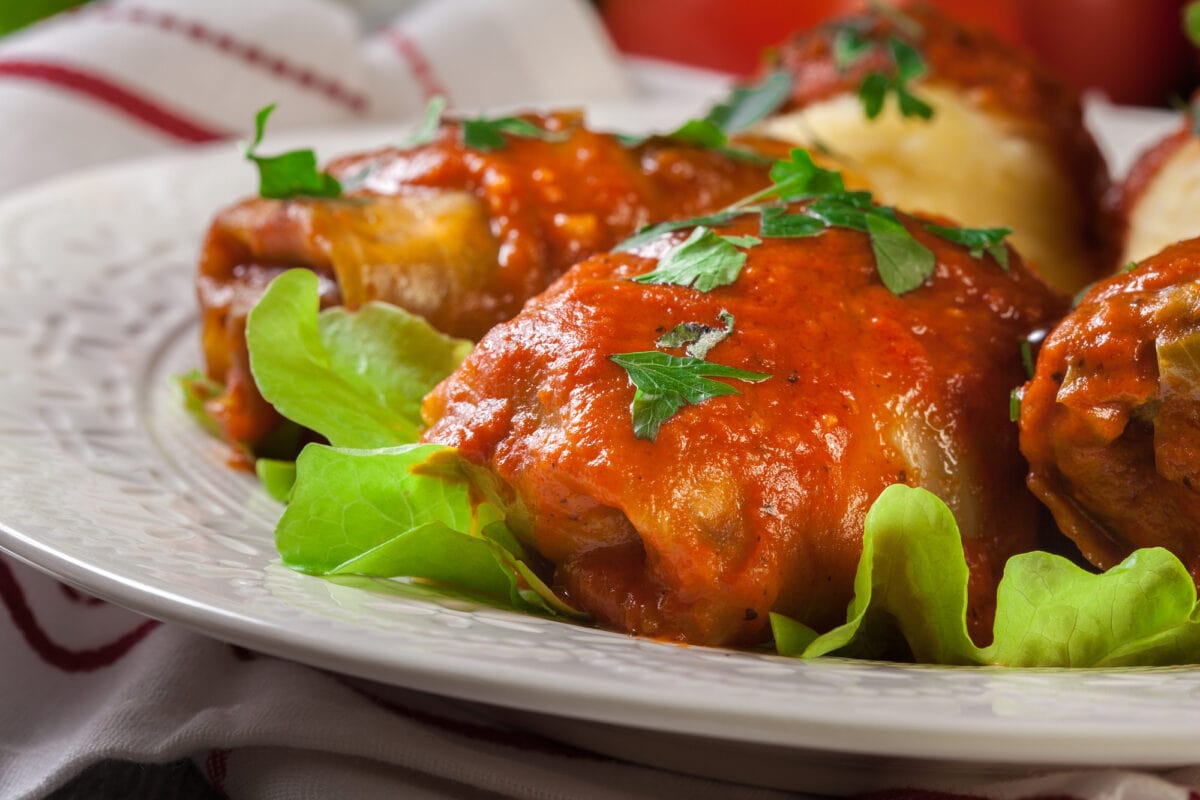
Cabbage rolls are served with a tasty tomato sauce and these days come in all kinds of vegan, vegetarian and gourmet versions.
Carrot tzimmes
Tzimmes can be made of other vegetables instead of carrots but traditionally it is a sweetened mash of carrots with raisins or prunes and is flavoured with honey and cinnamon. If there is leftover brisket that often goes into a tzimmes. It is eaten year-round but considered a special delicacy on Rosh Hashanah when sweet foods dominate to herald the coming of a sweet new year.
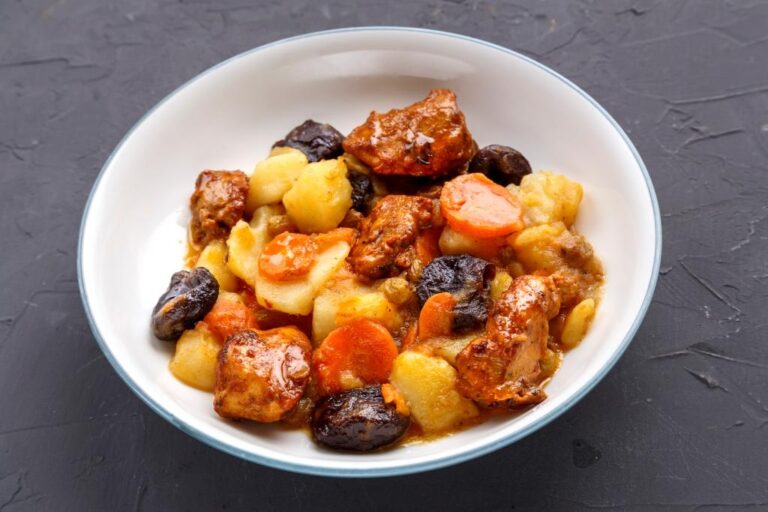
Potato bourekas
Originally found in the Middle East and popular in Sephardic food the bourek is another fabulous handheld pie. It uses vegetables that were difficult to get in Europe such as artichokes, pine nuts, squash and spinach. The dough is thin and crispy and stuffed with a selection of minced meats, spinach and cheese and other interesting ingredients.
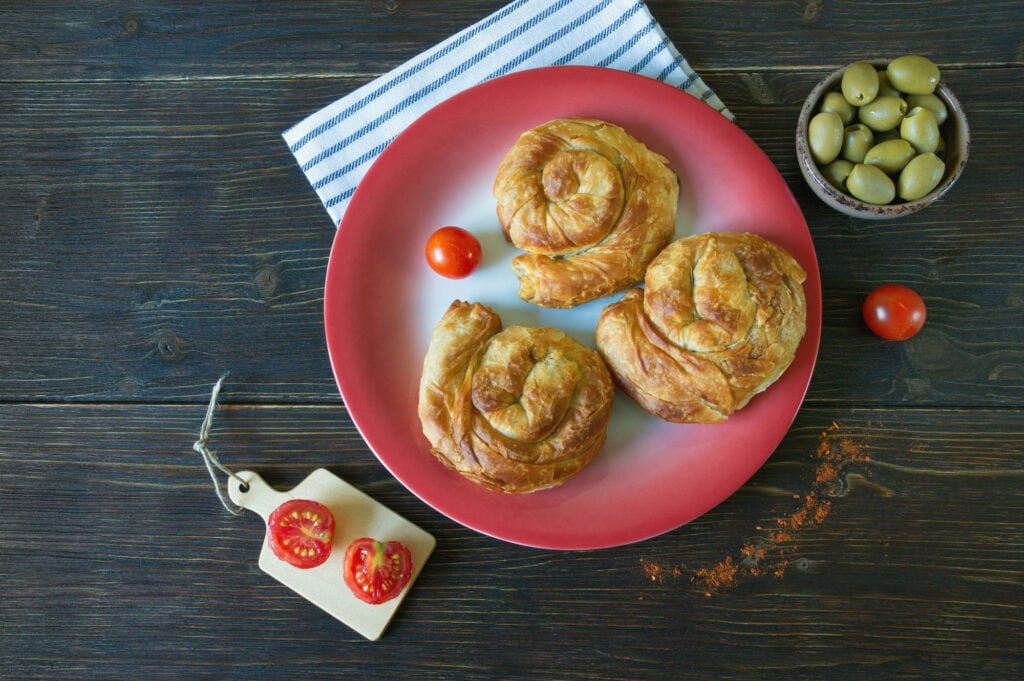
Chamin/Cholent
Cholent or Chamin is a slow-cooked meat stew that is prepared before the Sabbath so that it doesn’t require the use of a stove or electricity for observant Jews. Cholent is an ancient term that may have been French as in Chaud-lent which means to warm slowly. Cholent is the meal eaten after Shul on Saturday.

Blintzes
Similar to a crepe a blintz is a thin type of pancake that is filled with a cream cheese mixture and served with sour cream and a fruit sauce or topping.
However, unlike the crepe or pancake blintzes are only cooked on one side and then filled. The filling is usually comprised of cottage cheese or ricotta mixed with cream cheese, vanilla and sugar to add sweetness.
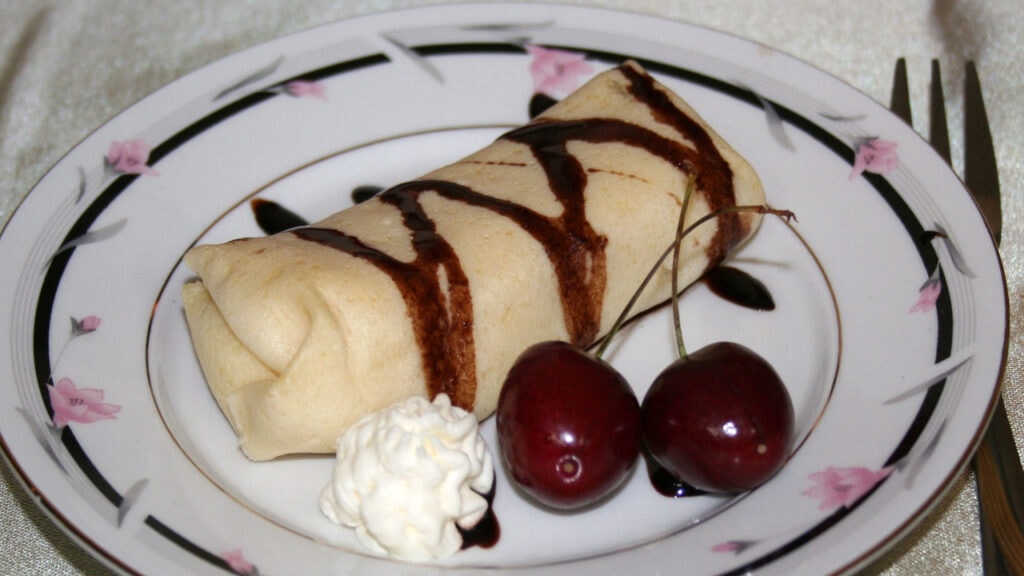
Brisket
Who doesn’t know brisket? A traditional cut that is usually served on special occasions and holidays. Brisket is cut from the front part of the cow and tends to be a tougher cut of meat so needs long braising to be tender. It used to be budget meat but these days some have turned it into a gourmet delicacy. It is the perfect dish for cooking the day before Shabbat.

Pastrami
Another ongoing debate between Montreal and New York is which is better Pastrami or Montreal Smoked? Pastrami was essentially created by Jewish people of Romanian origin. It is usually made from beef brisket, and sometimes from lamb, or turkey. The raw meat is brined, partially dried, seasoned with herbs and spices, and then smoked and steamed.

Montreal Smoked meat
Montreal Smoked meat, on the other hand, is made from the navel or plate cut of beef. It is also dry-cured like Pastrami but it is then soaked to remove the salt and smoked to imbue the cut with flavour.
Sufganiyot
Food served on Hanukkah is traditionally fried in oil to represent the oil supply that kept the candles lit. These include sufganiyot which are raspberry or strawberry jam doughnuts, sprinkled with sugar.
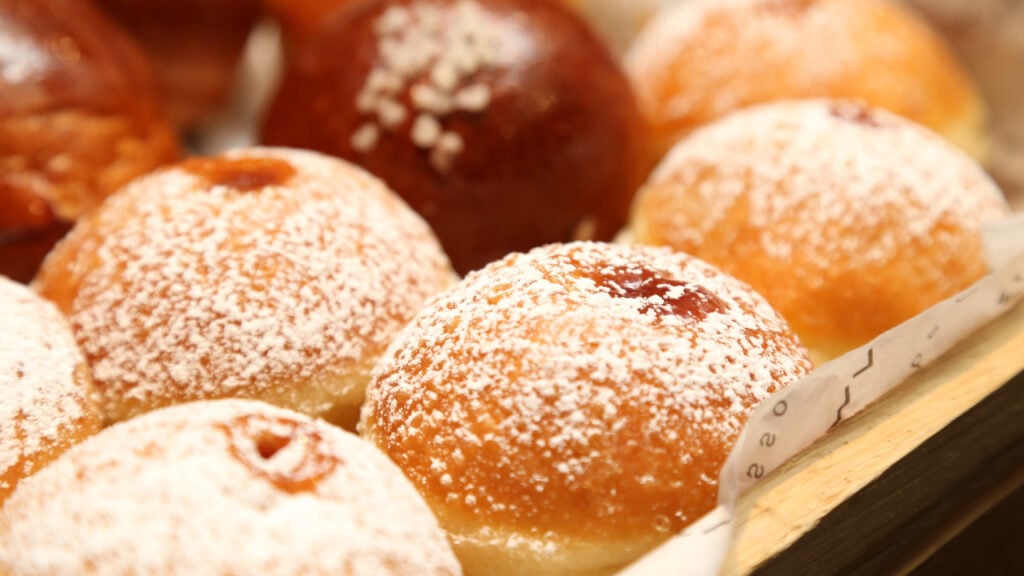
As you can see Jewish food culture has travelled the world and back again and can be found in any corner where you may care to travel to. Where have you found Jewish Food?
You may also like
UNESCO Intangible Cultural Heritage – food
Indigenous foods around the world
Croatian food – Discovering the delicious food of Croatia
Armenian food – 45 Armenian dishes you must try
Lebanese Food – 38 traditional Lebanese dishes
Pin it to save it
